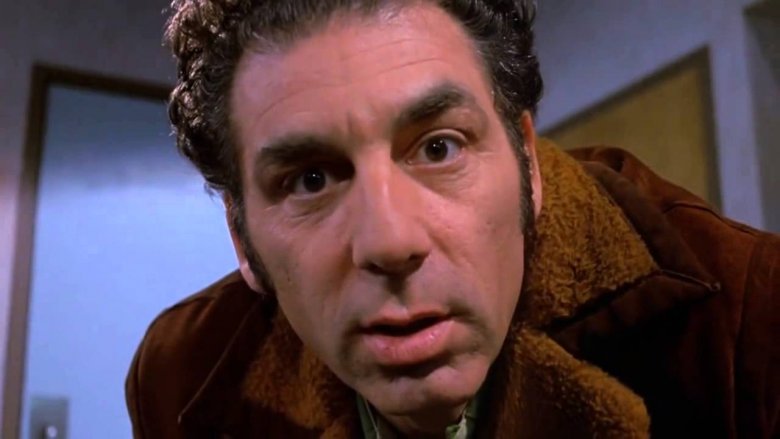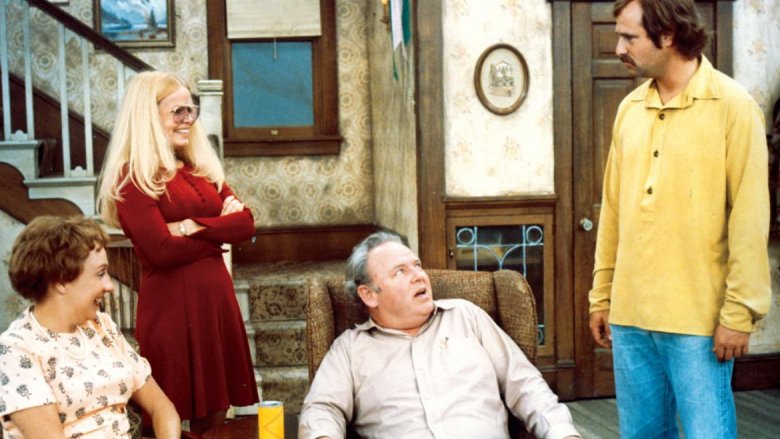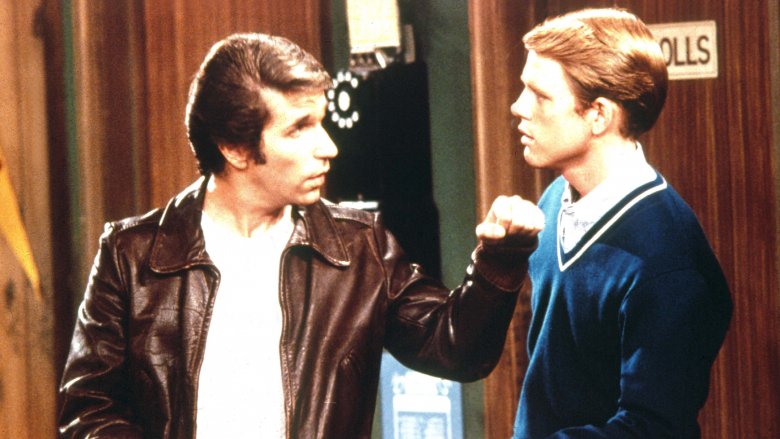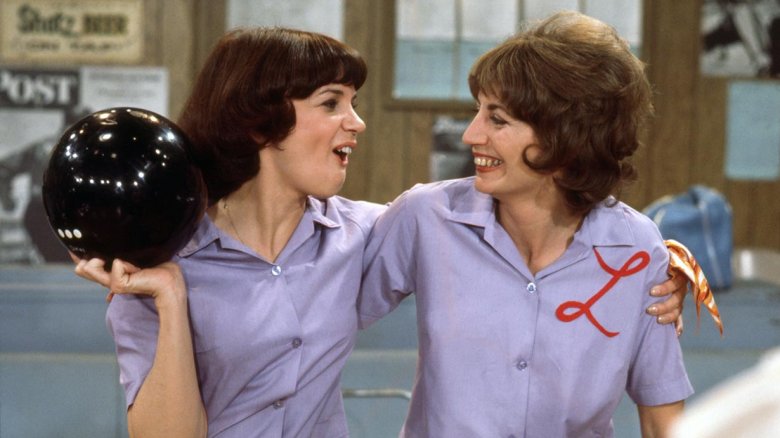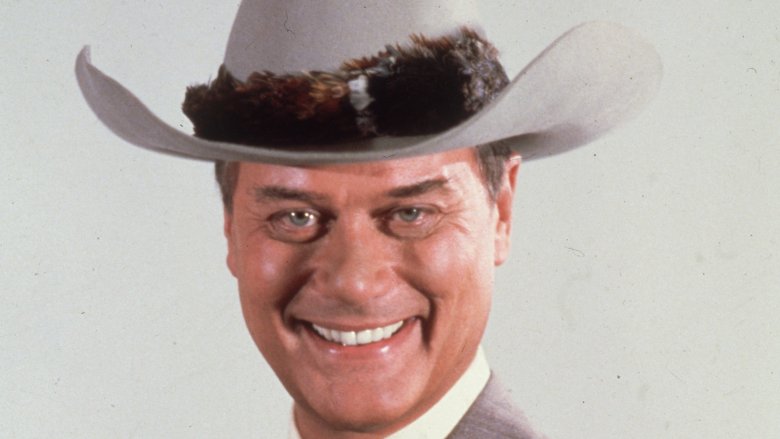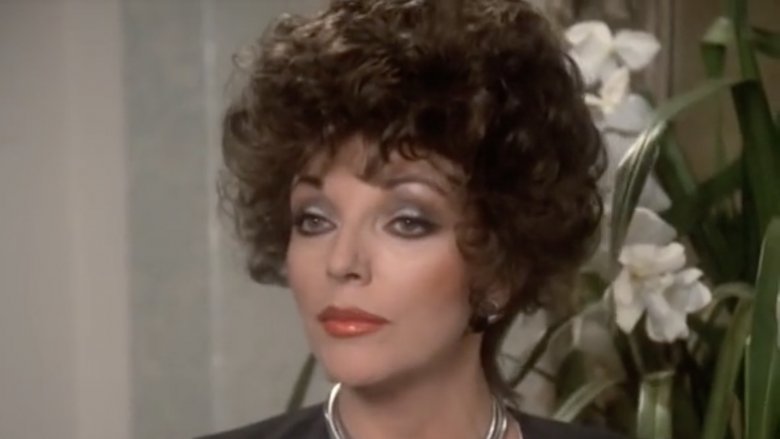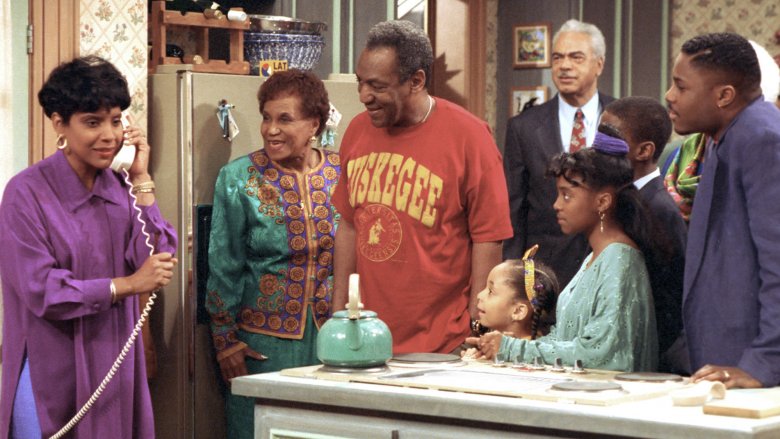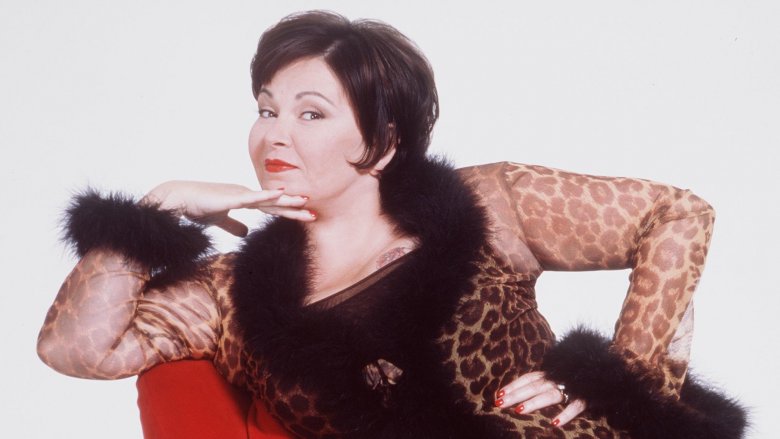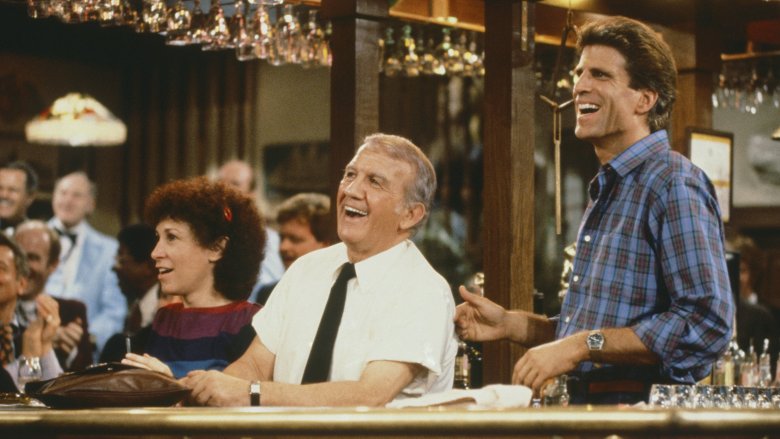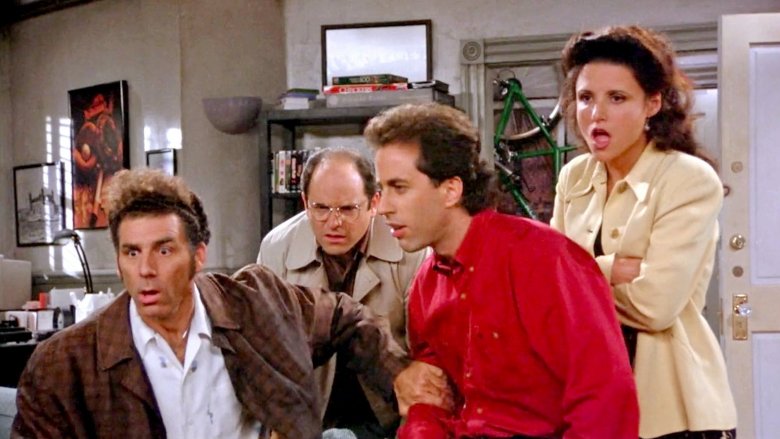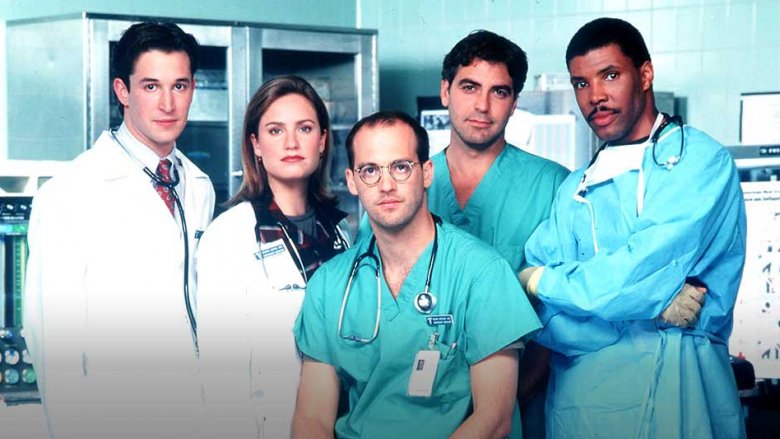The Most Popular TV Show The Year You Were Born
It's fun to imagine what the world was like around the time we each entered it. It's also an interesting conundrum — we were technically alive and a part of the world the year we were born, but also too young to remember anything, and too tiny to actively participate in it. Thanks to the memory of others and the internet, we can put the pieces together to create an image or sense of what was going on at the time of our infancy. Specifically, what were people into back then? Which TV shows were millions tuning into every week?
Here are the most popular TV shows of each of the last 40-odd years — in other words, the show that topped the Nielsen TV ratings chart (as listed in The Complete Directory to Prime Time Network and Cable Shows). But really, these are the shows our parents were probably bummed about missing because they were too busy giving birth to us or too tired from taking care of us, and they didn't have Hulu or Netflix to use for catch-up purposes.
1972–1976: All in the Family
The social upheaval and woke social change of the youth of the late '60s gave way to...more social upheaval and woke social change in the 1970s. It also led to a fierce resistance to change by, generally speaking, the older, more conservative generation that President Nixon called "the silent majority." All across America, lots of families' family time consisted of aging parents arguing with their long-haired, liberal offspring about the Vietnam War, equal rights, and the merits — or lack thereof — of Nixon.
Norman Lear deftly put all of that up on the screen, and appealed to both sides, with All in the Family. Most of the action in this play-like series took place in the sitting room of the New York brownstone of Archie Bunker (Carroll O'Connor), an angry, working-class, unrepentant, epithet-spewing racist butting heads with his daughter Gloria (Sally Struthers) and her husband Mike, whom Archie not-so-affectionately called "Meathead." Attempting to barely keep the peace was Archie's wife and Gloria's mother, Edith "Dingbat" Bunker. All in the Family was one part sitcom, one part public affairs discussion series, and it so resonated with Americans that it stayed atop the ratings all the way until the disco era.
1977: Happy Days
Although it wasn't all that far in the past, Americans in the mid-'70s came down with a bad case of nostalgia for the late '50s and early '60s, including classic cars, drive-ins, diners, and quaint early rock n' roll. (The '70s were a dark time from which people needed escape, what with Watergate, the Vietnam War, escalating crime rates, and the popularity of Anne Murray.) George Lucas' smash hit American Graffiti gave rise to its TV clone, Happy Days, about a wholesome Midwestern family named the Cunninghams. The Andy Griffith Show child star and future Oscar-winning director Ron Howard played wide-eyed high schooler Richie Cunningham, who hung out at Arnold's Diner with friends like Potsie, Ralph Malph, and Arthur "Fonzie" Fonzarelli, quite possibly the most popular and coolest character in television history: He wore a leather jacket, rode a motorcycle, could make a jukebox play by hitting it, and summoned young women with a snap of his fingers. Ayyyyyyy.
1978–1979: Laverne and Shirley
Here's the rare example of a spinoff succeeding the original show in terms of ratings popularity. The characters of Laverne and Shirley were introduced in an episode of Happy Days — Richie and Potsie date a couple of older women from the city who are a bit faster and more rough-around-the-edges than they're used to. When Garry Marshall gave the characters their own sitcom, they got softened and fleshed out — Laverne (Penny Marshall) was edgy, Shirley (Cindy Williams) a bit more optimistic, and they were roommates, best friends, and co-workers at the Shotz Brewery in the late 1950s and early 1960s. Often literally bouncing off each other with an energy like Martin and Lewis or Laurel and Hardy, Laverne and Shirley balanced their time at the bottling plant with hanging out at Laverne's father's restaurant and fending off the advances of their nerdy and obnoxious friends, Lenny (Michael McKean) and Squiggy (David Lander).
1980, 1983, 1992–1994: 60 Minutes
60 Minutes has been a part of the CBS lineup since 1967 — it's easily the longest-running show in primetime history. A pioneer in TV news, it's among the first "newsmagazines" — more than just a rundown of the day's top stories or headlines, each episode takes a deep dive into its subject matter, which can range from corporate malfeasance to government conspiracy to celebrity interview. It's produced a few moments of world-changing journalism over the years, such as Mike Wallace's 1995 story about tobacco industry whistleblower Jeffrey Wigand, the inspiration for the 1999 Oscar-nominated movie The Insider. But perhaps 60 Minutes' most famous contribution to the culture: the show-ending palate-cleanser "A Few Minutes with Andy Rooney," in which the veteran humorously complained about whatever he felt like complaining about, like viewer gifts or bottled water.
Watching 60 Minutes is a weekly Sunday night tradition, and it's that time slot that's helped it succeed. It starts right after (or is often pre-empted by) CBS's extremely popular NFL football coverage.
1981, 1982, 1984 : Dallas
Primetime soaps were the biggest TV fad in the late '70s and early 1980s — sagas about huge families trying to wrest control of lucrative businesses away from one another, with plenty of murder, affairs, fake deaths, kidnappings, and underhanded financial tricks providing salacious and ridiculous twists and turns each week. The biggest primetime soap of them all was Dallas, about the Ewing family and its massive, Texas-based oil company, headed by the downright evil J.R. Ewing (Larry Hagman) in spite of his many romantic partners, kids, and opponents. Dallas was insanely popular, topping the ratings for four straight years. It also produced one of the most-watched TV events ever: the two-part "Who Shot J.R.?" cliffhanger. At the end of one season, an unknown assailant put a bullet in the ruthless baron of industry; their identity — it was J.R.'s sister-in-law, Kristin Shepard (Mary Crosby) — wasn't revealed until the next fall.
1985: Dynasty
By 1985, the popularity of Dallas had diminished slightly, but audiences still wanted to see rich people behaving ridiculously badly on primetime television. ABC happily obliged with Dynasty, which was also about oil barons. (Hey, if it ain't broke, don't fix it.) John Forsythe portrayed tycoon Blake Carrington, who marries his much younger secretary Krystle (Linda Evans), to the chagrin of the rest of the Carrington family. In the second season, Joan Collins joined the cast as Blake's ex-wife Alexis Carrington, which is when Dynasty picked up speed. It struck the perfect balance between soapy drama, intrigue, glamour, and unnecessary voyeuristic violence — all the ingredients for a #1 TV series in the decade of excess. It just wasn't a proper episode of Dynasty if it didn't end with Alexis and Krystle getting into an argument and then trying to claw each other's eyes out and slap each other around while wearing extremely expensive and bedazzled evening gowns.
1986–1989, 1990 (tie): The Cosby Show
It's admittedly a very small element of why the horrible allegations and charges against Bill Cosby are so terrible, but it's unfortunate that The Cosby Show is forever tainted. Debuting on NBC in 1984 when sitcoms were not terribly popular, The Cosby Show was lovingly crafted to be both fresh and realistic as well as a groundbreaking portrayal of African-Americans rarely seen on network TV. Both of the parents, Cliff (Bill Cosby) and Clair Huxtable (Phylicia Rashad) were professionals — a physician and a lawyer, respectively, and their five children all both met and bristled under their parents' high standards.
The Cosby Show often played fast and loose with sitcom standards to get its messages across. One episode consisted mostly of a lecture about African-American art; another involved a visitation to a historically black college to increase awareness of historically black colleges. On the other end of the spectrum, some episodes had almost no plot at all — just the family hanging around the house and showing how great it was for a family to be together. The Cosby Show was an unstoppable juggernaut and for years anchored NBC's Thursday lineup, which also included classics like Cheers, Family Ties, and Night Court.
1990 (tie): Roseanne
Roseanne was a lot like The Cosby Show in that it broke new ground in television representation — rarely had anyone attempted a show about a blue-collar Midwestern family with two working parents. But Roseanne was also the anti-Cosby Show, in that its characters were not nearly as together as the Huxtables. The Conner family on Roseanne, built in part around comedian Roseanne Barr's sarcastic housewife or "domestic goddess" routines, teased each other, struggled financially, and had messy lives with real-world problems that never resolved at the end of a 22-minute episode. For example, Roseanne Conner (Roseanne Barr) worked one low-paying, low-prestige job after another, while her not-perfect, not-precocious kids gave her and husband Dan (John Goodman) a lot of pushback. And yet there was a ton of love fueling everything. It was such an indelible portrait of a particular kind of American family that ABC revived Roseanne for a 2018 run, more than 20 years after it initially went off the air.
1991: Cheers
Cheers was so different from other sitcoms on the air at the time that when it debuted in 1982 that it was nearly canceled. A breezy, low-key series for grown-ups about a Boston bar and its staff — particularly the will-they-or-won't-they dynamic between cocky, ex-jock owner Sam Malone (Ted Danson) and snooty waitress Diane Chambers (Shelley Long), the show attracted so few viewers that it was came close to getting the axe. But then it inexplicably won the Emmy for Outstanding Comedy Series in 1983 — an award for which it would be nominated for every season of its 11-year run. Its ratings improved, of course, and by season 9, enough people wanted to check in where "everybody knows your name" and to see what Sam, Diane (later replaced by Kirstie Alley as new romantic foil Rebecca Howe), bartender Woody (Woody Harrelson) waitress Carla (Rhea Perlman) and barflies Norm (George Wendt) and Cliff (John Ratzenburger) were up to each week that it was the most-watched show on television.
1995, 1998: Seinfeld
Finally, after years of shows about things, along came a show about nothing. Except that Seinfeld was about something — the hilariously dark and selfish impulses of a quartet of nasty New Yorkers. With the help of stand-up and comedy writer Larry David, Jerry Seinfeld turned his scattered observational comedy into one of the most intricately written, inventive, and original sitcoms ever made. It also up-ended the traditional sitcom formula; flying in the face of contemporaries like Full House or Home Improvement, Seinfeld and David's mantra was "no hugs, no learning." That thesis fueled countless classic moments, from Jerry stealing a loaf of bread from an old woman to George popping the protective bubble of a immune-deficient "Bubble Boy" and Kramer messing up an operation by dropping a Junior Mint from a surgical theater. Americans loved being dazzled by a Seinfeld episode's multiple disparate storylines that somehow all connected to each other at the end, and it beat everything else on the air for two TV seasons.
1996–1997, 1999: ER
For the first time in more than a decade, the TV ratings were dominated by a drama — because it was one of the most astonishing and exciting dramas ever made. The fast-paced, ultra-realistic ER had quite a pedigree working for it. It was created by bestselling novelist Michael Crichton (inspired by his doctor days) and produced by Steven Spielberg's Amblin Entertainment. Set in a big-city emergency room, high stakes, life-or-death, can't-look-away drama was guaranteed in every episode. Breaking up the tension and giving viewers a breather between all the racing gurneys and rapid-fire intubations were scenes involving the doctors' personal lives. Those moments were just as captivating, because stars George Clooney, Julianna Margulies, Noah Wyle, Sherry Stringfield, and Eriq La Salle were good-looking people with very good acting chops. ER was a mainstay of NBC's schedule for 15 seasons, and during more than one of those seasons, it was the most watched show on TV.
